Delta Scuti (δ Sct) is a variable yellow-white giant located 201 light years away in the constellation Scutum. The evolved star serves as the prototype for a class of variable stars known as the Delta Scuti variables. It is the fifth brightest star in Scutum. Its brightness varies from magnitude 4.60 to 4.79.
Star type
Delta Scuti is a yellow-white giant star of the spectral type F2 IIIp. Some sources give the spectral classification F2II-III, indicating a star with a luminosity class between a giant and bright giant.
Delta Scuti has a mass of 1.97 – 2.27 solar masses and a radius between 4.07 and 4.25 solar radii. With an effective temperature of 7,000 K, it is between 36.3 and 38.7 times more luminous than the Sun. It spins with a projected rotational velocity of 25.5 km/s.
Even though it has already evolved away from the main sequence, Delta Scuti is much younger than the Sun. It has an estimated age of 1.03 – 1.09 billion years. It has evolved faster than the Sun because it has more than twice the Sun’s mass.
Delta Scuti has two visual companions. Both are background stars that appear in the same line sight. One has an apparent magnitude of 12.2 and appears at a separation of 15.2 arcseconds from δ Sct, and the other shines at magnitude 9.2 and appears 53 arcseconds away.
Delta Scuti serves as the prototype for a class of stars known as the Delta Scuti variables. The star’s brightness varies by 0.19 magnitudes due to radial and non-radial pulsations. Non-radial pulsations are those that cause some parts of the stellar surface to move inwards while others simultaneously move outwards. Radial pulsations are those when the star expands and contracts by altering the radius in order to maintain its spherical shape. As the giant star pulsates, its radius changes by 0.3 to 0.9 percent.
Delta Scuti pulsates in multiple radial and non-radial modes. Astronomers have identified a total of eight different frequency modes.
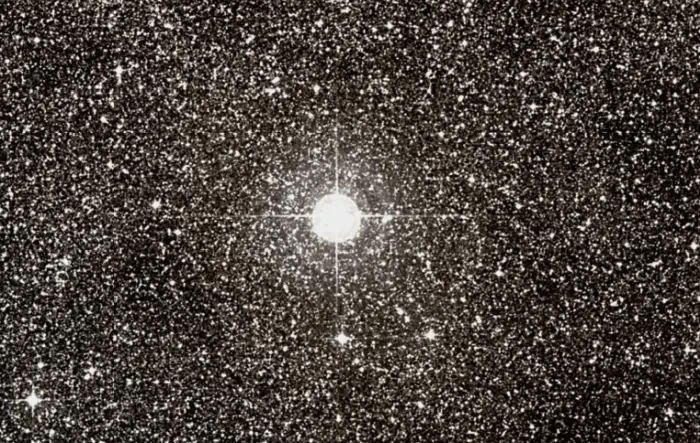
Delta Scuti, image credit: ESO/Digitized Sky Survey 2 (CC BY 4.0)
Delta Scuti variables
Delta Scuti variables are pulsating stars of spectral types A or F whose brightness varies as a result of pulsations. Also known as dwarf Cepheids, these stars typically vary in brightness by 0.003 to 0.9 magnitudes over a period of several hours.
Delta Scuti stars pulsate when they reach the classical Cepheid instability strip, a region of the Hertzsprung-Russell diagram that intersects the main sequence in the region of A- and F-type stars and moves to G- and early K-type supergiants.
Delta Scuti variables follow a period-luminosity relation in some passbands, which makes them useful as standard candles for measuring distances to star clusters, galaxies, and other extragalactic objects. The luminosity of these stars is known and, by comparing it to the stars’ visual brightness, astronomers can determine distances to various deep sky objects.
Relatively bright Delta Scuti variables include Altair (Alpha Aquilae) in the constellation Aquila, Denebola (Beta Leonis) in Leo, Caph (Beta Cassiopeiae) in Cassiopeia, Tureis (Rho Puppis) in Puppis, Polaris Australis (Sigma Octantis) in Octans, Rho1 Sagittarii in Sagittarius, Beid (Omicron1 Eridani) in Eridanus, Rho Tauri, Upsilon Tauri and Theta2 Tauri in Taurus, Salm (Tau Pegasi) in Pegasus, Epsilon Cephei in Cepheus, and Seginus (Gamma Boötis), Xuange (Lambda Boötis) and Iota Boötis in Boötes.
IK Pegasi, the nearest supernova candidate to the Sun, is also a Delta Scuti variable.
Other suspected Delta Scuti stars include Vega (Alpha Lyrae) in the constellation Lyra, Alderamin (Alpha Cephei) in Cepheus, and Zeta Ursae Minoris in Ursa Minor.
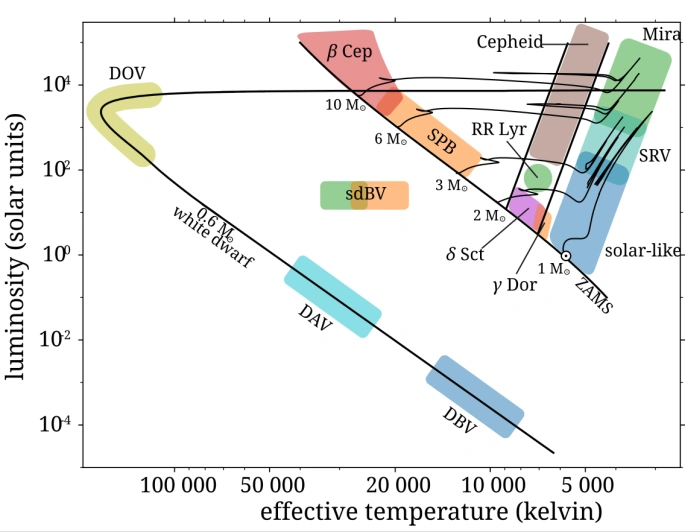
A Hertzsprung–Russell diagram, showing the luminosities and surface temperatures at which many classes of pulsating stars are found. Additional lines indicate where stars are found when they first fuse hydrogen into helium (zero-age main sequence, ZAMS), evolutionary tracks for stars of masses between 1 and 10 times that of the Sun, and the track along which a typical white dwarf of about 60% the Sun’s mass cools. Image credit: Wikimedia Commons/Warrickball (CC BY-SA 4.0)
Facts
The variability of Delta Scuti was first reported by American astronomers William W. Campbell and William H. Wright at Lick Observatory, California, in 1900. The astronomers used the 3-prism Mills spectrograph and found that the star had a variable radial velocity. It was one of the nine stars reported to be spectroscopic binary systems because of the variable velocities in the line of sight.
In 1935, A. Colacevich used the Mills spectrograph and found that the star’s radial velocity was variable with a period of 0.19377 days, or 4 hours, 38 minutes, and 9 seconds. Colacevich found an amplitude of the velocity curve of 8 km/s. The light variation of 0.2 magnitude, combined with the small amplitude and short period, indicated that Delta Scuti was not a real spectroscopic binary system, but that the changes in its luminosity were intrinsic.
In 1938, T. E Sterne discovered a secondary period, which led to a pulsation theory as an explanation for the variation in brightness.
Delta Scuti is moving towards Earth with a radial velocity of -43 km/s. The star’s orbit through the Milky Way galaxy has an eccentricity of 0.11. As the star orbits through our galaxy, it comes within 22,310 light-years of the Galactic centre and moves as far away as 27,590 light-years.
If the star maintains its brightness and motion, it will come within 10 light years of the solar system and become the brightest star in Earth’s sky between the years 1150000 and 1330000. With an apparent visual magnitude of -1.84, it will be brighter than Sirius is today (mag. -1.46).
Name
Delta Scuti does not have a proper name formally approved by the International Astronomical Union (IAU). It is commonly referred to by its Bayer designation, Delta Scuti. It has the Flamsteed designation 2 Scuti.
German astronomer Johann Bayer and British astronomer John Flamsteed did not assign these designations to the star themselves. The constellation Scutum did not exist in Bayer’s time and Flamsteed did not recognize it. The star was originally given the Flamsteed designation 2 Aquilae, and it was the American astronomer Benjamin Apthorp Gould who later gave it the designation Delta Scuti.
Location
Delta Scuti lies in the region near the semi-circle of stars around Lambda Aquilae, one of the stars in the conspicuously bird-like constellation figure of Aquila (the Eagle). The variable star forms an elongated diamond pattern with Alpha, Beta, and Gamma Scuti. It appears close to the midpoint of the imaginary line connecting Lambda Aquilae and Gamma Scuti.
The bright open cluster Messier 26 (M26) appears about 50 arcminutes southeast of Delta Scuti. A line drawn from Alpha through Delta leads to the cluster. With an apparent magnitude of 8.0 and an apparent size of 14 arcminutes, the cluster can be observed in small binoculars. It lies 5,160 light years away and spans 22 light years.
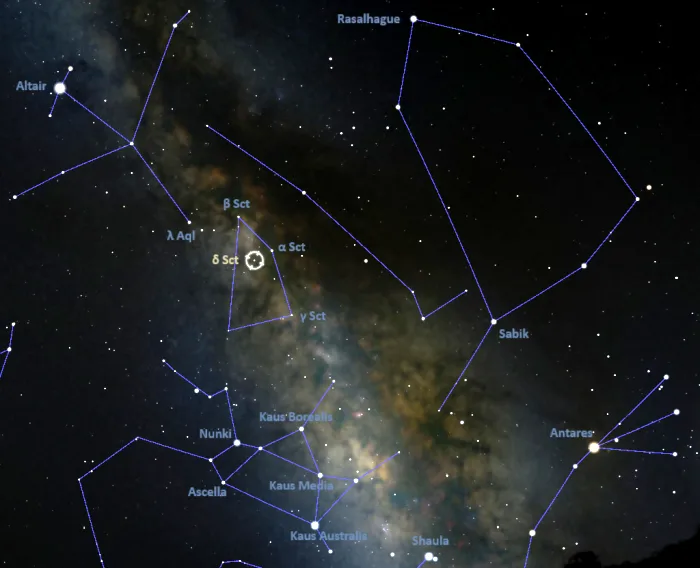
The location of Delta Scuti, image: Stellarium
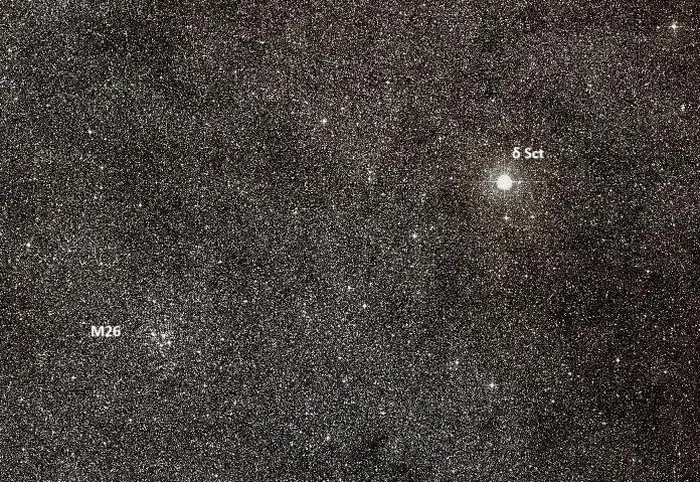
Delta Scuti and Messier 26, image credit: ESO/Digitized Sky Survey 2 (CC BY 4.0)
Constellation
Delta Scuti is located in the constellation Scutum. Representing the Shield, Scutum was introduced by the Polish astronomer Johannes Hevelius (Jan Heweliusz) in 1684. The constellation was created to commemorate the Polish King John III Sobieski and his victory in the Battle of Vienna in 1683. Hevelius originally named it Scutum Sobiescianum, the Shield of Sobieski.
Occupying an area of only 109 square degrees of the sky just south of the celestial equator, Scutum is the 84th largest of the 88 modern constellations. It lies in the region between the brighter and larger Sagittarius, Aquila and Serpens.
Scutum is one of the fainter constellations. It does not contain any stars brighter than magnitude 3.0. Alpha Scuti, the constellation’s brightest star, is an orange giant that shines at magnitude 3.83 from a distance of 199 light-years. It is the only star in Scutum that is brighter than magnitude 4.0.
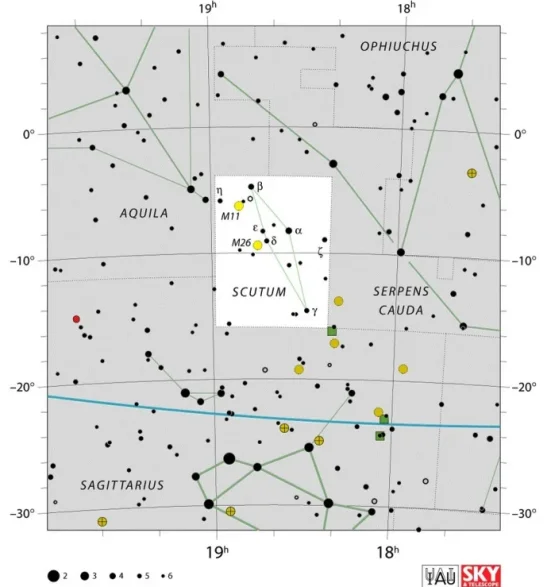
Scutum constellation map by IAU and Sky&Telescope magazine (Roger Sinnott & Rick Fienberg) (CC BY 3.0)
Other relatively bright stars in the constellation include the yellow bright giants Beta Scuti and Epsilon Scuti, the yellow giant Zeta Scuti, the A-type main sequence star Gamma Scuti, and the orange giant Eta Scuti. The constellation also contains the variable yellow supergiant R Scuti, the post-AGB star AS 314, and several of the largest stars known, including the red supergiants or hypergiants Stephenson 2-18, UY Scuti, and RSGC1-F01.
Notable deep sky objects in Scutum include the bright open clusters Messier 11 (the Wild Duck Cluster) and Messier 26, the globular cluster NGC 6712, and the planetary nebulae IC 1295 and M1-63.
The best time of the year to observe the stars and deep sky objects in Scutum is during the month of August, when the constellation is higher above the horizon in the early evening. The entire constellation is visible from virtually anywhere for at least part of the year.
The 10 brightest stars in Scutum are Alpha Scuti (mag. 3.83), Beta Scuti (mag. 4.22), Zeta Scuti (mag. 4.66), Gamma Scuti (mag. 4.67), Delta Scuti (mag. 4.60 – 4.79), Eta Scuti (mag. 4.83), Epsilon Scuti (mag. 4.88), HD 175156 (mag. 5.08), HD 171391 (mag. 5.12), and R Scuti (mag. 4.2 – 8.6).
Delta Scuti
| Spectral class | F2 IIIp or F2II-III |
| Variable type | Delta Scuti |
| U-B colour index | +0.16 |
| B-V colour index | +0.35 |
| Apparent magnitude | 4.60 – 4.79 |
| Absolute magnitude | 0.72 ± 0.04 |
| Distance | 201 ± 1 light years (61.8 ± 0.4 parsecs) |
| Parallax | 16.1899 ± 0.1157 mas |
| Radial velocity | −42.83 ± 1.21 km/s |
| Proper motion | RA: +7.300 ± 0.131 mas/yr |
| Dec.: +1.212 ± 0.097 mas/yr | |
| Mass | 1.97 – 2.27 M☉ |
| Luminosity | 36.3 – 38.7 L☉ |
| Radius | 4.07 – 4.25 R☉ |
| Temperature | 7,000 K |
| Metallicity | 0.41 dex |
| Age | 1.03 – 1.09 billion years |
| Rotational velocity | 25.5 km/s |
| Surface gravity | 3.5 cgs |
| Constellation | Scutum |
| Right ascension | 18h 42m 16.4268984096s |
| Declination | −09° 03′ 09.188922060″ |
| Names and designations | Delta Scuti, Delta Sct, δ Scuti, δ Sct, 2 Scuti, 2 Sct, 2 Aquilae, 2 Aql, HD 172748, HR 7020, HIP 91726, SAO 142515, FK5 1486, BD−09°4796, BD-09 4796A, PLX 4311.00, GC 25580, GCRV 11143, PPM 202045, SKY# 34326, CSI-09 4796 1, PMC 90-93 1054, Renson 48450, TD1 22985, GEN# +1.00172748, GSC 05692-02505, JP11 3007, N30 4146, ROT 2640, SACS 409, SV* P 4827, HERZ 2209, UBV 21631, UBV M 23150, WEB 15779, uvby98 100172748, YZ 99 6279, TIC 162499828, TYC 5692-2505-1, IRAS 18395-0906, 2MASS J18421642-0903092, AAVSO 1836-09, Gaia DR2 4155413814250528128, Gaia DR3 4155413814250528128, ADS 11581 A, CCDM J18423-0903A, IDS 18368-0909 A, WDS J18423-0903A |